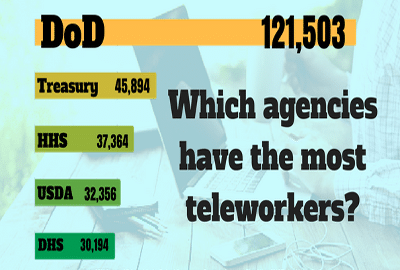
Telework: Heading in two different directions?
While some agencies are cutting back on the number of teleworkers, and the time they can spend working from home, others are thinking about expanding it to cut real...
Some feds — both friends and foes of teleworking — think the practice of permitting people to work from home is at a cross-roads.
While some agencies are cutting back on the number of teleworkers, and the time they can spend working from home, others are thinking about expanding it to cut real estate costs.
The U.S. Treasury Inspector General for Tax Administration said the IRS spends about $600 million each year on rent and other real estate costs, and that it is only using between 60 and 70 percent of its work stations. One possible solution would be to allow more people to telework and share work spaces, saving the IRS an estimated $80 million over the next five years.
In the meantime, over at the Social Security Administration officials are sensitive to complaints from first-time applicants and other customers about long waiting periods. So lay part of the blame on teleworkers who, they say, should be at the office dealing directly with customers.
Here are two comments from feds, one in the D.C. area and the other from west of the Mississippi River:
Anonymous: “I read your column on teleworking. Here is my story:
“I do not telework as a habit. The main reason is if the office is closed for bad weather so are the schools, which means the kids are home. It’s tough to telework with kids home. Those who telework are expected to work while those who do not get admin leave. But there is a place for it.
“In 2017, my eldest son who lived over 1,000 miles from me was diagnosed with cancer. He needed me to help him with getting back and forth to surgery, hospitals, doctor visits, tests, [chemotherapy], housekeeping, cooking, etc. I had been saving up my sick leave as I only take it when needed. I had use-or-lose annual leave in excess of 100 hours, but knew I was going to be needed for a couple of months.
“My agency allowed me to use Family Medical Sick Leave, Annual Leave, and Telework to keep up with the stuff at the office. I ended up teleworking about 20 hours per week in between chemo treatments, as he would have chemo about five hours a day for five days and then a couple of weeks to recover between treatments. He ended up in [the intensive care unit] and the hospital for a total of seven days, and I was able to be there by his side.
“I didn’t need to request to be a leave recipient using all of these options. I didn’t use all of my sick leave or annual leave. And most important for the agency, I didn’t leave the job undone or my duties thrown onto co-workers for 11 weeks.”
Angilhart: “I am a current federal employee and have consistently seen problems with federal managers to be able to telework. Teleworking programs do often become a way to show favoritism. As with everything else, telework is up to the final decision of the immediate supervisor. I have seen several supervisors who will not allow a regular scheduled telework but will allow it continuously to specific employees. More often than not this is not based on work output but personal favoritism.
“Agencies also advertise telework as a benefit to draw people to the agency, then to be informed [it is] not available or any number of excuses that they can come up with. I personally have disabilities so some telework is preferred for success. I do not run errands or babysit as I have seen others post. I have seen first-hand where an agency advertises for people with disabilities to come to work for them.
“They also advertise that they have been consistently rated one of the best places to work in the federal government. You accept a job and then hit a wall. You file for reasonable accommodations and they ignore you, then the write-ups start and [it] begins to occur to you that they would rather get rid of you. Ultimately you have to file an EEO complaint. There goes your career possibilities because you are marked. This is an example of how a positive program is turned into a negative.
“As far as work life balance, telework provides some real felt advantage. I live 40 miles from my job. I have to travel the Interstate 95 corridor. On days that I telework it adds three to four hours a day to my day that I’m not just sitting in the car, and without office distractions.
“Telework is a good program in my opinion. It is also a program that the supervisor needs to monitor in a unbiased way. Good management and employee responsibilty are the key points and lack of either shouldn’t justify taking it away from everyone.”
Nearly Useless Factoid
By Amelia Brust
The largest and farthest water reservoir ever detected in the universe holds the equivalent of 140 trillion times all the water in Earth’s ocean. It surrounds a quasar — a large, feeding black hole — more than 12 billion light-years away.
Source: NASA
Copyright © 2025 Federal News Network. All rights reserved. This website is not intended for users located within the European Economic Area.
Mike Causey is senior correspondent for Federal News Network and writes his daily Federal Report column on federal employees’ pay, benefits and retirement.
Follow @mcauseyWFED





